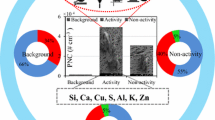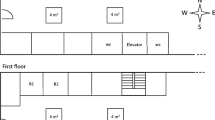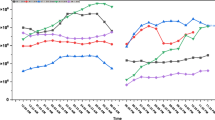Abstract
Building activities are recognised to produce coarse particulate matter but less is known about the release of airborne ultrafine particles (UFPs; those below 100 nm in diameter). For the first time, this study has investigated the release of particles in the 5–560 nm range from three simulated building activities: the crushing of concrete cubes, the demolition of old concrete slabs, and the recycling of concrete debris. A fast response differential mobility spectrometer (Cambustion DMS50) was used to measure particle number concentrations (PNC) and size distributions (PNDs) at a sampling frequency of 10 Hz in a confined laboratory room providing controlled environment and near–steady background PNCs. The sampling point was intentionally kept close to the test samples so that the release of new UFPs during these simulated processes can be quantified. Tri–modal particle size distributions were recorded for all cases, demonstrating different peak diameters in fresh nuclei (<10 nm), nucleation (10–30 nm) and accumulation (30–300 nm) modes for individual activities. The measured background size distributions showed modal peaks at about 13 and 49 nm with average background PNCs ~1.47 × 104 cm−3. These background modal peaks shifted towards the larger sizes during the work periods (i.e. actual experiments) and the total PNCs increased between 2 and 17 times over the background PNCs for different activities. After adjusting for background concentrations, the net release of PNCs during cube crushing, slab demolition, and ‘dry’ and ‘wet’ recycling events were measured as ~0.77, 19.1, 22.7 and 1.76 (×104) cm−3, respectively. The PNDs were converted into particle mass concentrations (PMCs). While majority of new PNC release was below 100 nm (i.e. UFPs), the bulk of new PMC emissions were constituted by the particles over 100 nm; ~95, 79, 73 and 90% of total PNCs, and ~71, 92, 93 and 91% of total PMCs, for cube crushing, slab demolition, dry recycling and wet recycling, respectively. The results of this study firmly elucidate the release of UFPs and raise a need for further detailed studies and designing health and safety related exposure guidelines for laboratory workplaces and operational building sites.





Similar content being viewed by others
References
Andronache C, Gronholm T, Laakso L, Phillips V, Venalainen A (2006) Scavenging of ultrafine particles by rainfall at a boreal site: observations and model estimations. Atmos Chem Phys 6:4739–4754
Blake LS (1989) Civil Engineer’s Reference Handbook. 4th Edn. Oxford: Butterworth-Heinemann, London
Brouwer D (2010) Exposure to manufactured nanoparticles in different workplaces. Toxicol 269:120–127
Brouwer DH, Gijsbers JHJ, Lurnvink MWM (2004) Personal exposure to ultrafine particles in the workplace: exploring sampling techniques and strategies. Ann Occup Hyg 48:439–453
Brouwer D, van Duuren-Stuurman B, Berges M, Jankowska E, Bard D, Mark D (2009) From workplace air measurement results toward estimates of exposure? Development of a strategy to assess exposure to manufactured nano-objects. J Nanopart Res 11:1867–1881
BS EN 12390-4:2000 (2000) Testing hardened concrete. Compressive strength. Specification for testing machines ISBN 0580354008
BS EN 12390-2:2009 (2009) Testing hardened concrete. Making and curing specimens for strength tests. ISBN 9780580670688
BS EN 12390-3:2009 (2009) Testing hardened concrete. Compressive strength of test specimens ISBN 9780580587979
Buonanno G, Morawska L, Stabile L (2009) Particle emission factors during cooking activities. Atmos Environ 43:3235–3242
Bystrzejewska–Piotrowska G, Golimowski J, Urban PL (2009) Nanoparticles: their potential toxicity, waste and environmental management. Waste Manag 29:2587–2595
Carpentieri M, Kumar P (2011) Ground-fixed and on-board measurements of nanoparticles in the wake of a moving vehicle. Atmos Environ 45:5837–5852
COSHH (2005) Control of substances hazardous to health (Fifth edn.). The control of substances hazardous to health regulation 2002 (as amended) approved code of practice and guidance L5, HSE Books, ISBN 978 970 7176 2981 7177
de Hartog JJ, Hoek G, Mirme A, Tuch T, Kos GPA, ten Brink HM, Brunekreef B, Cyrys J, Heinrich J, Pitz M, Lanki T, Vallius M, Pekkanen J, Kreyling WG (2005) Relationship between different size classes of particulate matter and meteorology in three European cities. J Environ Monit 7:302–310
Dorevitch S, Demirtas H, Perksy VW, Erdal S, Conroy L, Schoonover T, Scheff PA (2006) Demolition of high-rise public housing increases particulate matter air pollution in communities of high-risk asthmatics. J Air Waste Manag Assoc 56:1022–1032
Fuller GW, Green D (2004) The impact of local fugitive PM10 from building works and road works on the assessment of the European union limit value. Atmos Environ 38:4993–5002
Fuller G, Carslaw DC, Lodge HW (2002) An empirical approach for the prediction of daily mean PM10 concentrations. Atmos Environ 36:1431–1441
Hansen D, Blahout B, Benner D, Popp W (2008) Environmental sampling of particulate matter and fungal spores during demolition of a building on a hospital area. J Hosp Infect 70:259–264
Harrison RM, Beddows DCS, Dall’Osto M (2011) PMF analysis of wide-range particle size spectra collected on a major highway. Environ Sci Technol 45:5522–5528
HSE (2006) The assessment of different metrics of the concentration of nano (ultrafine) particles in existing and new industries. Health and Safety Executive Research Report RR513, pp 72
HSE (2010) Dust control on cut-off saws used for stone or concrete cutting. Health and Safety Executive Construction Information Sheet No 54 (Revision 1), pp 1–4
ILO (1995) Safety, health and welfare on construction sites: a training manual. International Labour Organization ISBN 92-2-109182-1, pp 134
Kittelson DB (1998) Engines and nano-particles: a review. J Aerosol Sci 29:575–588
Knibbs LD, Cole-Hunter T, Morawska L (2011) A review of commuter exposure to ultrafine particles and its health effects. Atmos Environ 45:2611–2622
Kuhlbusch T, Asbach C, Fissan H, Gohler D, Stintz M (2011) Nanoparticle exposure at nanotechnology workplaces: a review. Part Fibre Toxicol 8:22
Kukadia V, Upton S, Grimwood C (2003) Contorlling particles, vapour and noise pollution from construction sites; Part 2: Site Preparation, demolition, earthworks and landscaping. BRE Pollution Guide, pp 1–8
Kumar P (2011) Footprints of airborne ultrafine particles on urban air quality and public health. J Civil Environ Eng 1:e101: doi:10.4172/jcee.1000e4101
Kumar P, Fennell P, Britter R (2008a) Measurements of particles in the 5–1000 nm range close to road level in an urban street canyon. Sci Total Environ 390:437–447
Kumar P, Fennell P, Langley D, Britter R (2008b) Pseudo-simultaneous measurements for the vertical variation of coarse, fine and ultra fine particles in an urban street canyon. Atmos Environ 42:4304–4319
Kumar P, Fennell P, Symonds J, Britter R (2008c) Treatment of losses of ultrafine aerosol particles in long sampling tubes during ambient measurements. Atmos Environ 42:8819–8826
Kumar P, Fennell P, Hayhurst A, Britter RE (2009) Street versus rooftop level concentrations of fine particles in a Cambridge street canyon. Boundary-Layer Meteorol 131:3–18
Kumar P, Fennell P, Robins A (2010a) Comparison of the behaviour of manufactured and other airborne nanoparticles and the consequences for prioritising research and regulation activities. J Nanopart Res 12:1523–1530
Kumar P, Robins A, Vardoulakis S, Britter R (2010b) A review of the characteristics of nanoparticles in the urban atmosphere and the prospects for developing regulatory controls. Atmos Environ 44:5035–5052
Kumar P, Gurjar BR, Nagpure A, Harrison RM (2011a) Preliminary estimates of nanoparticle number emissions from road vehicles in megacity Delhi and associated health impacts. Environ Sci Technol 45:5514–5521
Kumar P, Ketzel M, Vardoulakis S, Pirjola L, Britter R (2011b) Dynamics and dispersion modelling of nanoparticles from road traffic in the urban atmospheric environment- a review. J Aerosol Sci 42:580–603
Kumar P, Robins A, Vardoulakis S, Quincey P (2011c) Technical challenges in tackling regulatory concerns for urban atmospheric nanoparticles. Particuology 9:566–571
Mann S (2006) Nanotechnology and construction. Nanoforum Report. Institute of nanotechnology, Stirling
McDonald PJ, Aptaker PS, Mitchell J, Mulheron M (2007) A unilateral NMR magnet for sub-structure analysis in the built environment: The Surface GARField. J Magn Reson 185:1–11
McGarry P, Morawska L, He C, Jayaratne R, Falk M, Tran Q, Wang H (2011) Exposure to particles from laser printers operating within office workplaces. Environ Sci Technol 45:6444–6452
Morawska L, Ristovski Z, Jayaratne ER, Keogh DU, Ling X (2008) Ambient nano and ultrafine particles from motor vehicle emissions: characteristics, ambient processing and implications on human exposure. Atmos Environ 42:8113–8138
Nazari A, Riahi S (2011) Splitting tensile strength of concrete using ground granulated blast furnace slag and SiO2 nanoparticles as binder. Energ Build 43:864–872
Nowack B, Bucheli TD (2007) Occurrence, behaviour and effects of nanoparticles in the environment. Environ Pollut 150:5–22
Park K, Cao F, Kittelson DB, McMurray PH (2003) Relationship between particle mass and mobility for diesel exhaust particles. Environ Sci Technol 37:577–583
Sanchez F, Sobolev K (2010) Nanotechnology in concrete-a review. Constr Build Mater 24:2060–2071
Schneider T, Brouwer DH, Koponen IK, Jensen KA, Fransman W, Van Duuren-Stuurman B, Van Tongeren M, Tielemans E (2011) Conceptual model for assessment of inhalation exposure to manufactured nanoparticles. J Expos Sci Environ Epidemiol 21:450–463
The Stationary Office (1974) Health and safety at work etc. Act. Ch37, ISBN 010543774
Tjoe Nij E, Hilhorst S, Spee T, Spierings J, Steffens F, Lumens M, Heederik D (2003) Dust control measures in the construction industry. Ann Occup Hyg 47:211–218
Wallace L, Ott W (2011) Personal exposure to ultrafine particles. J Expos Sci Environ Epidemiol 21:20–30
Acknowledgments
The authors thank Mr. Prasana Kunapalan, Mr. Fred Auckland, Mr. Thomas Pagkalis and Mr. Rex Packiyarajah for their help during the laboratory experiments. PK also thanks Drs. Hong Cheng and Vina Kukadia from the Building and Research Establishment (BRE), UK, for providing BRE pollution guide.
Author information
Authors and Affiliations
Corresponding author
Electronic supplementary material
Below is the link to the electronic supplementary material.
Rights and permissions
About this article
Cite this article
Kumar, P., Mulheron, M. & Som, C. Release of ultrafine particles from three simulated building processes. J Nanopart Res 14, 771 (2012). https://doi.org/10.1007/s11051-012-0771-2
Received:
Accepted:
Published:
DOI: https://doi.org/10.1007/s11051-012-0771-2




